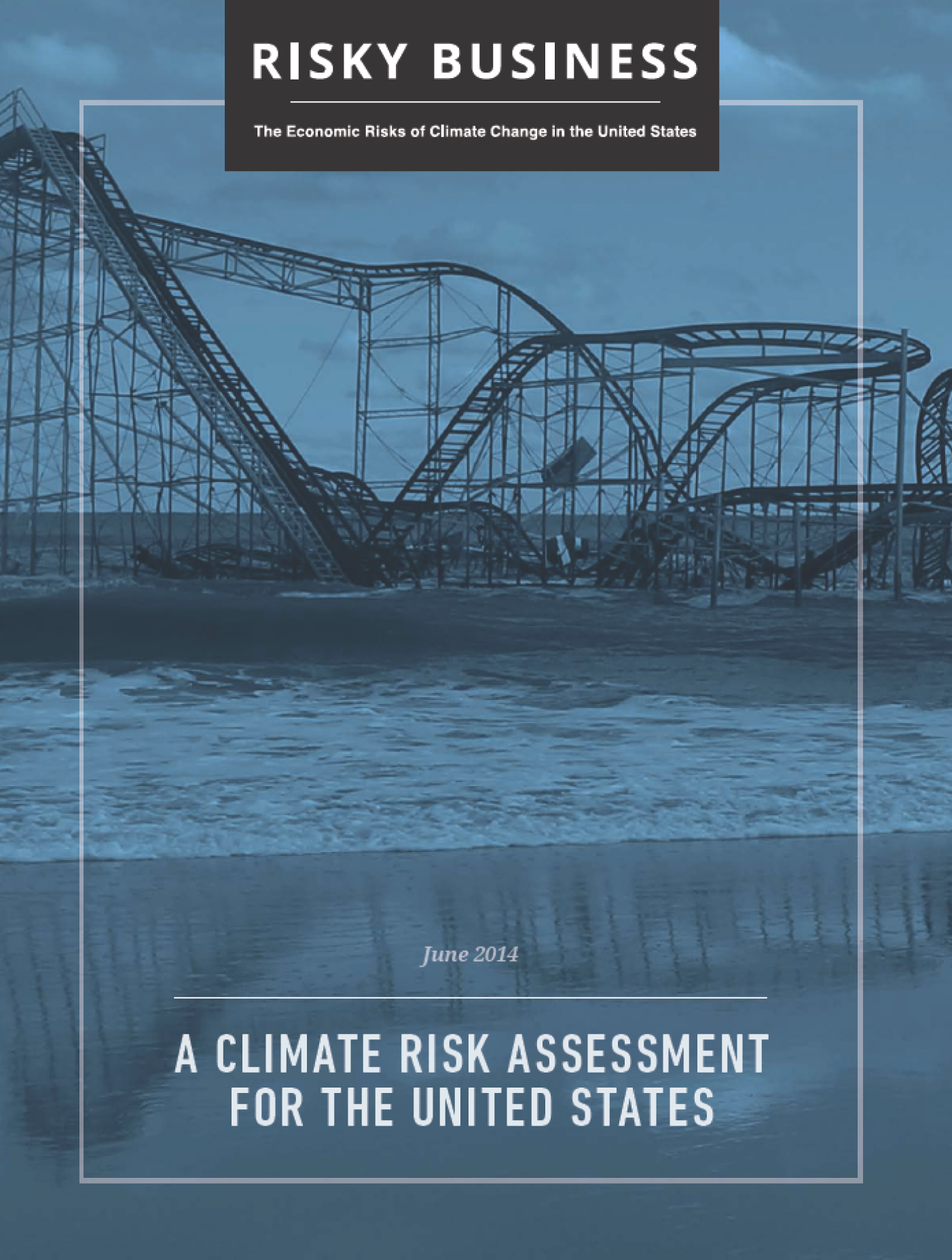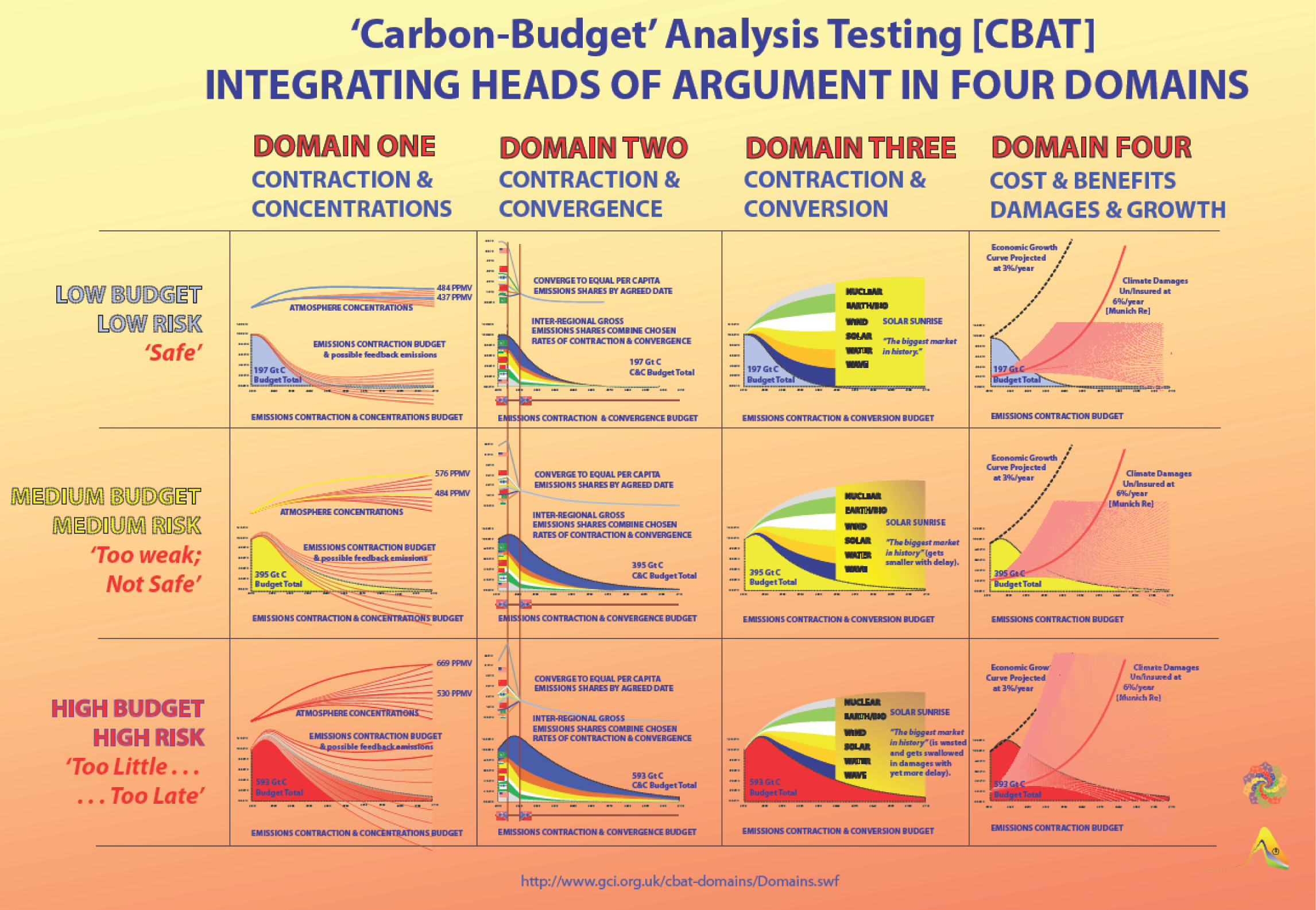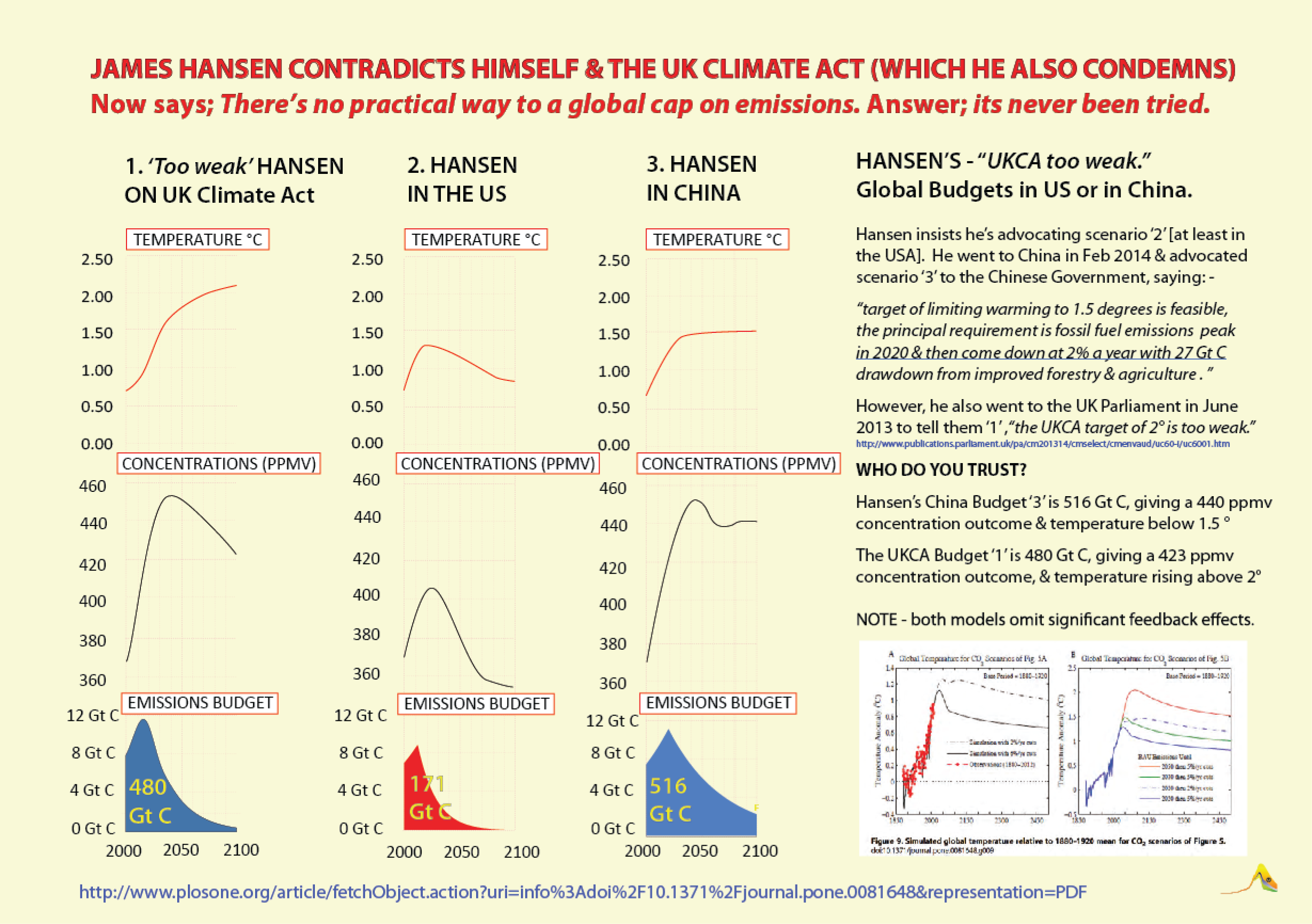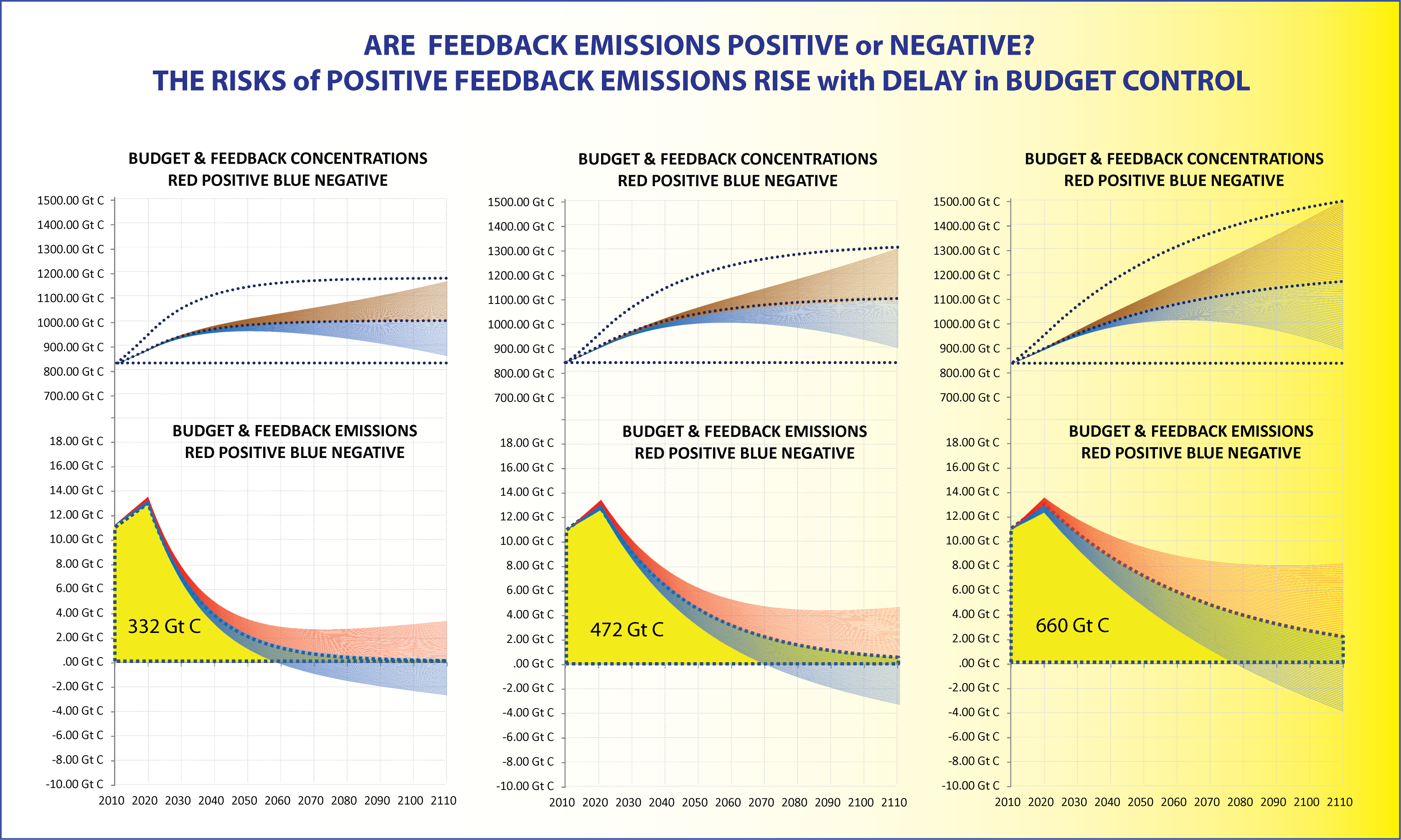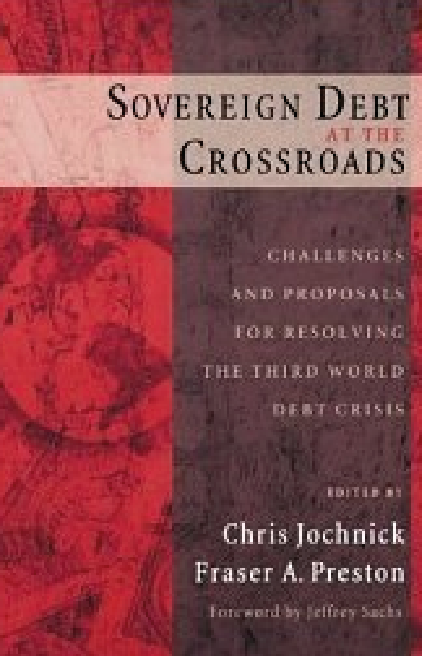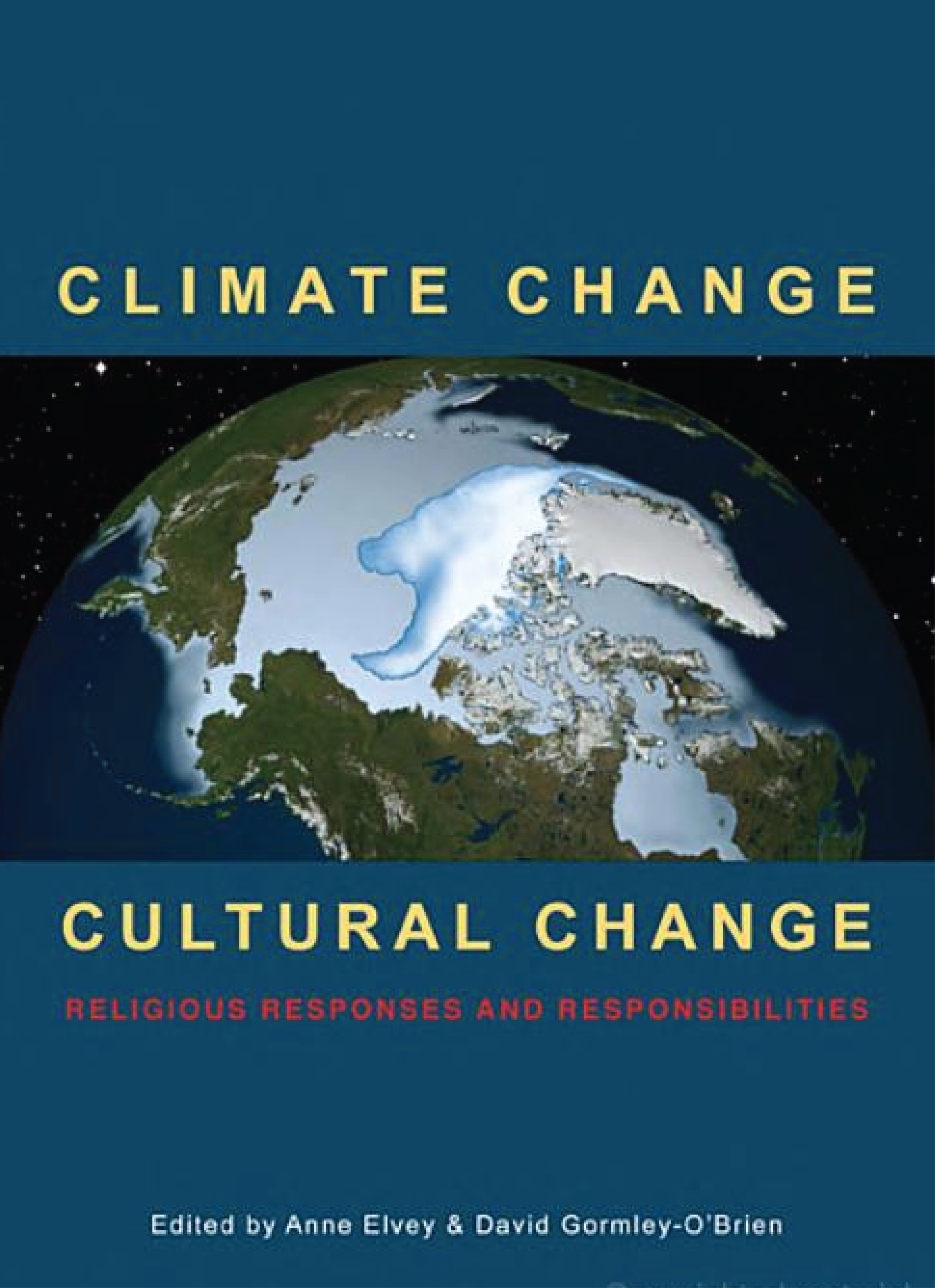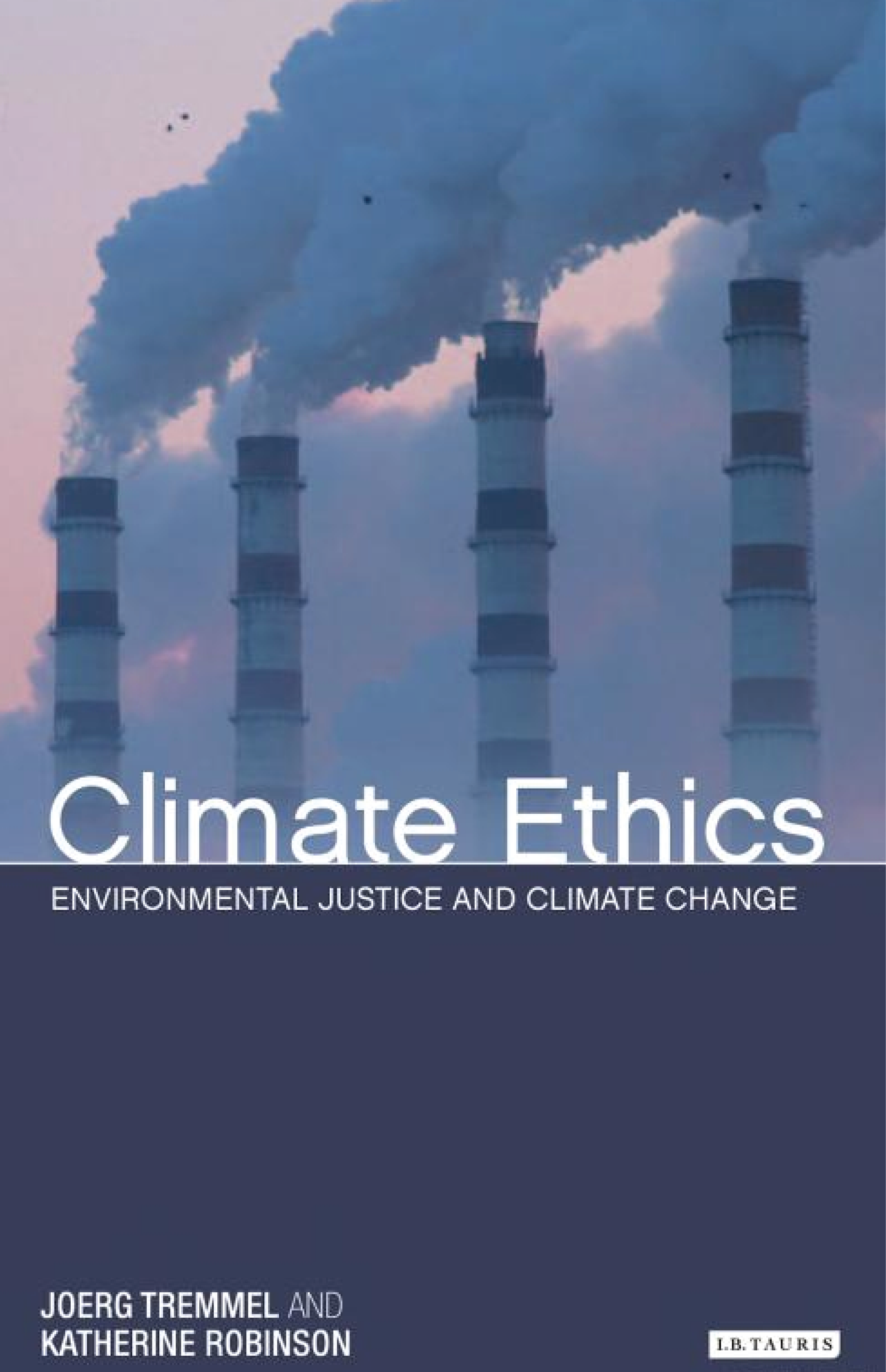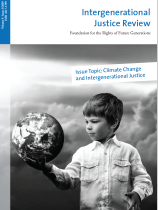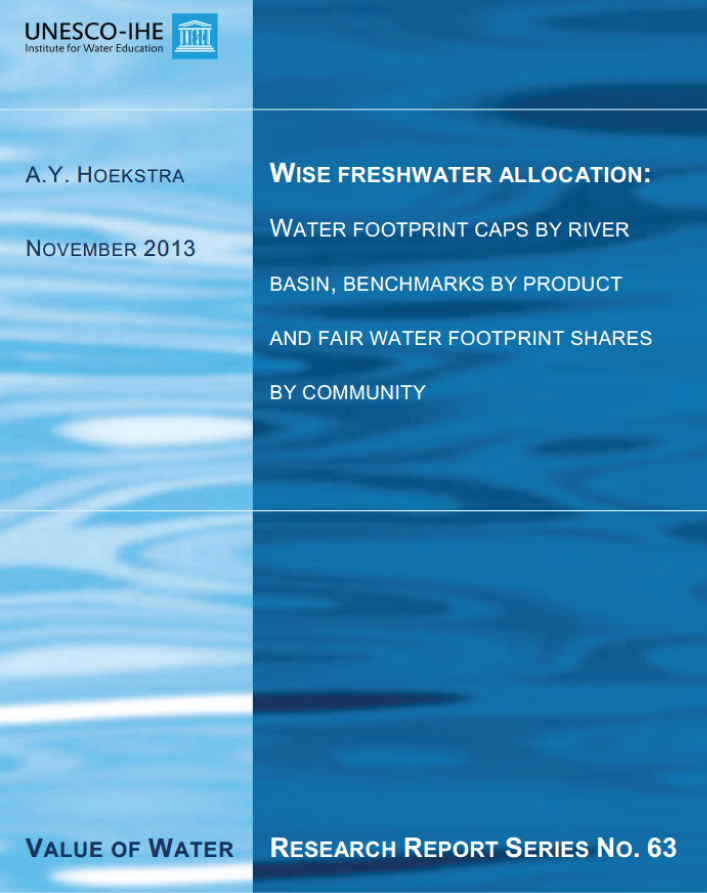Damages from storms, flooding, and heat waves are already costing local economies billions of dollars—we saw that firsthand in New York City with Hurricane Sandy. With the oceans rising and the climate changing, the Risky Business report details the costs of inaction in ways that are easy to understand in dollars and cents—and impossible to ignore.
Risky Business Project Co-Chair Michael R. Bloomberg
29 June 2014 - The dangers of doing too little too late. Overview of trend-potential of 'climate damage footprint' & runaway risk.If 'green growth' (zero carbon growth) is too slow, climate-damages will become too fast to prevent being overwhelmed by these . . . . and it will make a mockery of the whole 'green-growth' agenda.
To be reasonably 'safe' (low risk)
- carbon emissions need to be zero by around 2050 with a carbon budget around 200 GtC
- renewable replacements of carbon-based energy need to be 100% completed by that date
- or we'll be overwhelmed by the consequences of doing too little too late.
27 June 2014 - Hansen condemns UKMO's Climate Act as "too weak", & then propagates a climate-model that's weaker still.27 June 2014 - "C&C, a framework for negotiating international environmental agreements." Prof Brendan Mackey Griffiths University
Contraction & Convergence: a framework for negotiating international environmental agreements consistent with planetary boundaries
Wild Law Conference 27-29 September 2013, Ian Hangar Recital Hall, Qld Conservatorium, SouthBank Brisbane
Professor Brendan Mackey, PhD Director, Griffith Climate Change Response Program, Griffith University
email: b.mackey@griffith.edu.auAbstract
We find ourselves in difficult times with many planetary boundaries either breached or at straining point – the climate change problem and the biodiversity extinction crisis being two prominent expressions of this malaise.
Such global problems demand global solutions. The human species while rich in its diversity of cultural expressions and local contexts also has shared values, needs and aspirations. Irrespective of the source of our ethics (be it religion or humanism), at the most fundamental level we all believe that life is better than non-life, and accept the axiom that consequently we must be concerned for the quality of life lived.
Giving effect to this belief in turn demands we treat life with respect and care. Furthermore, we now find universal acceptance that (at least) all human life is of equal intrinsic value and therefore that solutions to global problems must serve equally all people’s concerns and capacities. Taking the climate problem as our focus, how can it be solved in ways consistent with these ethical foundations?
The solution lies is using ‘contraction and convergence’ (C&C) which was originally conceived and is still being promoted by Aubrey Meyer from the Global Commons Foundation as a framework for climate change treaty mitigation negotiations. However, C&C is equally applicable to all global environmental problems where the problem hinges on equitable distribution over time of a finite natural resource.
Other issues to which it has been applied include global animal protein supply and rare earth metals. In this presentation I explain the principles of C&C, explore some related justice issues, and discuss how it can help the international community secure the “real deal” – one that results in legally binding mitigation commitments that will stabilize atmospheric concentrations of greenhouse gases at a level within the planet’s safe operating space.
27 June 2014 - Is High Frequency Trading Good? Then look at Carbon Trade (Key Question: is there a global carbon budget or not?).Is High Frequency Trading (HFT) A Good Or Bad Thing For FX?
What is High Frequency Trading (HFT)?
It is basically letting computers take over your trades and getting in and out of positions very very fast; faster than any human could manually trade, in seconds or fractions of a second.How Is It Done?
The trades are done based on complicated algorithms and trading strategies on super fast and gigantic computers. It’s practically a game of who got in and out of the market first and faster. It’s like running into Macy’s first thing in the morning on black Friday, getting the best things for the best price and reselling them for a higher price to the next person. And then doing it a million times more. In forex, it’s practically betting on every fraction of the moves the currency pairs make on the forex dance floor. - See morePublicly listed inter-dealer broker ICAP plc has issued a press release announcing an executive shakeup in the company’s ICAP Securities and Derivatives Exchange (ISDX). The new CEO of the unit will be Patrick Birley – a long-time industry veteran with a substantial amount of executive experience, who ran LCH.Clearnet before becoming CEO of the European Climate Exchange back in 2007.
Mr. Birley’s career started at the South African Futures Exchange (SAFEX), where he was the second employee. After spending 13 years as CEO, building it into one of the most active derivatives exchanges in the world, he led the sale of SAFEX to the Johannesburg Stock Exchange. He later became CEO and Risk Management director at LCH.Clearnet where he spent just over a year before joining the European Climate Exchange.
He was indignant to environmentalists’ charges that ‘dirty capitalists’ should not be able to profit from trading carbon emissions throughout his three year position, moving on to his next role as senior adviser at the London Stock Exchange. - See more
In a nutshell - if there's no global carbon budget, this can only make a bad situation worse . . . . .
27 June 2014 - Shrink Carbon Budget; Lower PPMV; Faster Replacement Renewables; Lower Temperature
This will not happen by accident . . . There must be a legally-binding framework at the UNFCCC.
The threat of runaway rates of climate change developing now makes the whole matter urgent.
This dicates that rapid carbon contraction rates and international convergence rates within that based on C&C must be agreed no later than 2015.CBAT the 'Carbon Budgtet Accounting Tool' is a tool being developed to help that agreement come about.
Well Done to MEDACT and the Climate and Healthy Council on their success getting the BMA to vote for disinvestment in the fossil fuel industry, as reported in the Ecologist Magazine.
24 June 2014 - The challenge of measuring potentially Rapidly Interactive Feedback Effects (RIAFE). Acceleration is the issue . . .
The KEY ISSUE is comparing 'Keeping Control Curvature' as in the Classical Climate Models, which omit most feedback effects,
with the potential we all face with 'Losing Control Curvature' due to RIAFE-accelerated rates of change.19 June 2014 - CBAT is being redone, developed & hopefully completed in JAVA (and also undergoing a 're-brand')12 June 2014 - "How C&C Reconciles the Ecological Debt of Climate Change." Sovereign Debt at Crossroads; Jochnick Preston
The fact of ecological debt in an age of climate change moves the balance of power in international relations. Using ecological debt as both an analytical framework and political argument, it is possible to imagine a paradigm shift from centuries of global economic expansion and divergence to one of Contraction and Convergence (Meyer 2000). In other words, to imagine the architecture necessary for the global economy to work within natural limits and equitably distribute its benefits. It has become a logic necessary for our collective survival.
Contraction and Convergence
It is unlikely that everyone in the world will ever use identical amounts of fossil fuels. However, it is highly likely, says the RWEO that any deal to manage the global commons of the atmosphere will have to be based on the principle that, in a carbon-constrained world, everyone should have equal entitlements to their share of the atmosphere's ability to safely absorb pollution. Such an agreement implies that those people and nations that take the economic benefit, by polluting more than their fair share will have to somehow pay compensation to the "under-polluters" by purchasing their spare entitlements. Otherwise, they run up a huge ecological debt (Greenhill and Simms 2002). The process necessary is to cap total emissions, progressively reduce them and equally share entitlements to emit. If a target is set for an acceptable concentration of greenhouse gases in the atmosphere and an "emissions budget"' set to meet it, it becomes possible to work out for every year from now until the target is met everybody's logical and equal share of the atmosphere's ability to soak up our waste emissions.
To do this, a formula is used such that, in an agreed timeframe, entitlements to emit are pre-distributed in a pattern of international convergence so that, globally, shares become equal per capita. This procedure- unavoidable if chaos is to be prevented- was given the term "contraction and convergence" by the London-based Global Commons Institute (Meyer 2000). It is opposite to the dynamic that has characterised the global economy up to now.
In essence, it says that the world has a "carbon cake" strictly limited in size - beyond certain dimensions it rapid ly becomes poisonous for everyone - and that the only way to begin negotiations on how to cut the cake is to start with the principle that we all have equal access rights. What we do with them is another matter.
How Contraction and Convergence Reconciles the Ecological Debt of Climate Change
Under a plan proposed by Meyer (2000), all countries collectively agree on a target for a stable atmospheric concentration of carbon dioxide in the atmosphere. A "global emissions budget" is then calculated that is derived from the target atmospheric concentration figure. The target is reviewed annually so that it can be revised with new scientific findings. Once the "contraction budget" has been chosen, the next question is how to distribute the entitlements within it between countries. Under contraction and convergence, the allocations of emissions entitlements among countries would converge by a specific date. By that year, entitlements would be allocated in proportion to the national population in a specified baseline year. Full emissions-trading is a design feature of Ihe concept. Contraction and Convergence would reduce the complexity of climate negotiations to two simple variables that would need to be agreed upon: the target atmospheric concentration of CO2 and the date at which entitlements would converge at equal per capita allocations.
The approach offers the best chance of solving a great and immensely destructive international paradox. Less developed countries stand to be hit first and worst by global warming. The New Economics Foundation's report “The End of Development, Global Warming, Disasters and the Great Reversal of Human Progress" makes the case that all the internationally agreed targets for reducing poverty to emerge out of the 19905 decade-long series of UN conferences - collectively known as the Millennium Development Goals - will be tragically undermined by climate change (Simms and Walter 2002). Yet developing countries have been reluctant to play along with the climate negotiations as conducted to date. They see no reason - if rich countries have had a free ride on the Earth's finite fossil fuel resources for the whole of their development - that they should jeopardize their own development through accepting any perceived restraints on their economic activity. But contraction and convergence deals with this seemingly inescapable trap.
Developing countries have consistently refused to take part in a framework that pre-allocates the property rights to a finite carbon budget in a manifestly inequitable way- so-called grandfathering- in which the starting point is one where countries "inherit"' their historical emission levels. That approach creates in effect, a carbon aristocracy.
By specifying a set date for convergence at equal per capita rights, the contraction and convergence approach would give developing countries surplus emission allocations that they could then sell to countries thaI need extra permits - most of them developed countries. The revenue flow from the sale of surplus permits would give developing countries an income flow from climate change policy, which would encourage participation and would also create an added incentive to invest in clean technologies. Less developed countries also stand to benefit more the sooner such an agreement is made because as time passes, the cuts needed to prevent runaway global warming get bigger and so tradable emissions get fewer. And, in the interim, it means that rich over-polluting countries are abusing the global commons of the atmosphere without having to pay.
Contraction and Convergence and the United States
Interestingly, contraction and convergence would also fit with the stated position of the otherwise recalcitrant United States. In his statements on climate change, President George W. Bush has set out specific criteria for what sort of treaty the United States would be will ing to support. These include a truly global deal that includes emission targets [or from another perspective, entitlements] for developing countries and the need for a science-based approach. Contraction and convergence, with its global participation design and formal greenhouse gas concentration target is exactly such an approach. Contraction and Convergence is also fully consistent with the famous 1997 Byrd-Hagel U.S. Senate Resolution that stipulated that the United States would not be a signatory to any treaty that did not include developing countries.
Contraction and Convergence has enormous, and from a development perspective very positive, consequences in that it can liberate resources to finance development. But, as action to combat global warming is delayed, emissions grow and populations rise, the sustainable size of a carbon cake slice will get smaller and smaller. In other words, the sooner we act. the better.
But the notion that there are limits, however unpredictable and flexible within which we must work is still difficult for many to grasp. This can be demonstrated by how easily even senior civil servant can completely misunderstand the challenge. Take a graph from the U.K. governments environment department, DEFRA reproduced in the RWEO (figure 4.2). Without an overlong explanation, it's enough to say that their projection for cutting emissions to "stabilize" greenhouse gases at a certain level shows that by around 2070 there will be no fossil fuels at all for countries, outside the First World club - not a barrel of oil, heap of coal or canister of gas to burn. How they explain that logic to India, China, Brazil or Ethiopia will make for an interesting ministerial meeting. They have shown the necessary contraction but not the convergence. Yet the two must occur together.
There are several subtly differing equity-based proposals for global frameworks to tackle climate change that could supersede the Kyoto Protocol when the Protocol’s first phase has run its course in 2012. They are assessed in Evans (2002). Only Contraction and Convergence however, passes the tests for both environmental integrity- working within secure environmental limits - and political feasibility offering real entitlements to less developed countries.
It is all very well making abstract theoretical arguments, but is there any chance at all that the advanced industrial economies could possibly make the kind of resource cuts necessary to fit into such a model? History suggests the answer is yes.
War economies provide an approximate analogy (Simms 2001). All the major industrialized countries have relatively recent experience of them. They can generate senses of extended responsibility, purpose and focus. They always involve the complete re-gearing of the economy. The enemy here, of course, is a hostile climate, not another country. The victims of climate change could also be greater than in any war.
Resource efficiency was a major focus for British people during the Second World War. In the six years beginning in 1938, there was a 95% cut in private vehicle use. Public transport increased significantly. Consumption of all goods and services fell 16% in a similar period. A change in diet meant that although people were eating less, they were eating better, Life expectancy for people away from the bombs and bullets increased and infant mortality fell. For some, less really was more.
Behaviour changed partly in response to a massive government information campaign, itself amplified through media as far reaching as Good Housekeeping and Feeding cats and Dogs in Wartime. New patterns of behaviour became self-policing. Profligacy with food, material of fuel was seen as anti-social. Rationing was a fact and parameters were set by government, but without public support the country would have been ungovernable.
But is this asking too much of people in rich countries? Poor Countries with conventional foreign debts and lacking the systems of social support that the North enjoys, have lived with badly designed ‘structural adjustment programmes’ for decades. These are imposed to in the name of the economic discipline necessary to make debt repayments. To tackle the ecological debt of global warming, rich countries could now run the equivalent of environmental war economies, working within the framework of "sustainability adjustment programs”.
]n 1943, Hugh Dalton, President of the UK Board of trade, said, "There can be equality of sacrifice in the war. Some must lose their lives and limbs, others only the turn-ups on their trousers.” Today in Bangladesh some twenty million people are threatened by homelessness caused by flooding in order that we can drive sport-utility vehicles.
At the times of the first OPEC crisis, a US Congressional declaration of purpose to sahpe domestic policy called for “Positive and effective action” to protect “general welfare . . . [and] . . . conserve scarce energy supplies . . . [and] . . . ensure fair and efficiency distribution.” Applied more generally, there is a sentiment absolutely in line with contraction and convergence and a way of reconciling the ecological debt crisis.
But it is possible that neither the contraction and convergence framework nor the approach of the environmental war economy will succeed alone without reform of our monetary system to reconnect the abstract world of finance with the physical world of natural resources. Coming full circle, there was once a link between the money supply and gold and silver. Their availability was to a degree a limiting factor on what economies did.
If the trade in emissions permits were to be conducted in U.S. dollars for example, there would still be a built-in bias in favour of the dominant hard-currency countries. The United States could further exploit its position as the key currency holder and print money to meet its needs. This would mean that it could escape pressure to reform and entrench existing imbalances in the world economy.
The point is not to reduce the amount of energy that people use per se but to reduce the amount used that comes from fossil fuels.
A proposal for how this could be done comes from Richard Douthwaite [1999] He says spare emissions permits from under-consuming countries in the contraction and convergence framework could be traded in a special currency, the "EBCU" (energy-backed currency unit). The EBCU issue to governments would be a one-time event on the same per capita basis as the emission permits. Spare permits under a given ceiling would be made available upon payment in EBCUs.
Thereafter, when ‘spent’ the EBCUs are withdrawn from circulation, and used permits are destroyed. This strictly controls the volume of spare emissions permits or "special emissions rights" in the market. Such an approach creates a parallel monetary system and incentives to case the managed withdrawal from the fossil fuel economy. The complexity of implementation is reduced by the fact that, according to Douthwaite (1999). "80 percent of the fossil carbon that ends up as man-made CO2 in the earth's atmosphere comes from only 122 producers of carbon-based fuels.”
Sovereign Debt at the Crossroads
Chris Jochnick Fraser A Preston12 June 2014 - "Pentagon preparing for mass civil breakdown." Nafeez Ahmed in the Guardian
Pentagon preparing for mass civil breakdown Social science is being militarised to develop 'operational tools' to target peaceful activists and protest movements Share 166 1 inShare 14 Email Pentagon Building in Washington The Pentagon is funding social science research to model risks of "social contagions" that could damage US strategic interests. Photograph: Jason Reed/REUTERS A US Department of Defense (DoD) research programme is funding universities to model the dynamics, risks and tipping points for large-scale civil unrest across the world, under the supervision of various US military agencies. The multi-million dollar programme is designed to develop immediate and long-term "warfighter-relevant insights" for senior officials and decision makers in "the defense policy community," and to inform policy implemented by "combatant commands." More
Pentagon preparing for mass civil breakdown
Nafeez Ahmed
12 June 2014 - Potus Sclerotus? "Obama Plan Too Little Too Late." Bill Weinberg Global Justice Ecology Project
For the first time, the US Environmental Protection Agency has proposed to limit emissions of the greenhouse gas carbon dioxide from existing power plants, the single largest source of carbon pollution in the United States. The response has been predictable. Environment News Service notes: “Democrats and public health and environmental groups rejoiced in the proposal of a measure they have advocated for years to fight climate change, but Republicans cried doom, warning that the rule would destroy the American economy.” The New York Times writes: “[E]nvironmental advocates praised the proposed rule for its breadth and reach while the coal industry attacked it as a symbol of executive overreach that could wreak economic havoc.”The Daily Beast‘s Jason Mark dubbed the program “Obamacare for the Air” because both plans are “numbingly complex,” “based on a market system,” “likely to transform a key sector of the economy,” and “guaranteed to be intensely polarizing.” In other words, a market-based plan is being attacked by the right as green totalitarianism. This would be perverse enough if the plan’s goals were anywhere close to sufficient to actually address the climate crisis—which, again predictably, they are not. More
Obama climate plan: too little, too late
Bill Weinberg Global Justice Ecology Project
12 June 2014 - "C&C is the only way." Dr Mayer Hillman at the British Humanist Association makes a truly grim climate prognosis.
11 June 2014 -"Contraction & Convergence - universal protection to address climate change." Rajesh Makwana in SHOA
If advocates of the sharing economy are really motivated to tackle complex social and ecological issues, they should also devote time and energy to promoting forms of sharing that are far more effective at addressing these problems, such as universal social protection or contraction and convergence approaches to addressing climate change.This means moving beyond the solely personal, community and city-oriented view of sharing, and embracing a wider understanding of sharing that includes the role of governments in advancing effective social policy and environmental regulations. Most of all, it is at the national and global level that the sharing economy can be revolutionary and transformative – if its supporters are willing to engage in the gritty politics of reforming government policy to establish truly effective and ‘sharing’ societies.
Shoah launched on 1st January 2011
Shoah Mission: -
- The purpose of ‘Shoah’ is to advocate for the Human Rights of the Palestinians.
- We propose to support these rights by defying barriers imposed by the Zio-Nazi regime.
- We adhere to the principles of a Non-Violence in direct actions that exercise the Palestinian rights.
- Freedom of Expression Everyone has the right to opinion and expression; this right without interference and seek, through any media and regardless of frontiers.
11 June 2014 - "C&C the idea is hard to dispute." Climate Change Cultutral Change Religious Responses & Responsibilities, Elvey
One idea which is gaining considerable support is summarised as Contraction and Convergence The guiding principles are that every person has an equal right to pollute and global emissions must be consistent with agreed stabilisation targets. LIke the original UNFCCC the idea is hard to dispute.
Climate Change Cultural Change: Religious Responses and Responsibilities
edited by Anne Elvey, David Gromley-O'Brien
10 June 2014 - "Other distribution schemes can't compete with C&C." Climate Ethics Joerg Chet Tremmel Katherine Robinson
Climate Ethics: Environmental Justice and Climate Change
By Joerg Chet Tremmel, Katherine Robinson"Keeping in mind our provisions for future generations, how can atmospheric resources be fairly distributed among contemporaries. In Chapter 8 we posit that, according to the maxim of pure distributive justice, the presumption for equality applies: everyone gets an equal share of the pie; i.e. every one has the same grenhouse gas emissions budget. For a (static) world population of about 7 billion people and a 'safe emissions budget' of 560 gigatonnes, this results in per capita emissions budgets of 2 tonnes per year between 2010 and 2050. Divding the limited budget by the number of individuals corresponds to the ethical stance of emissions/certificate egalitariansim. It grants each person on the planet an equal share of atmospheric resources. This approach also called Contraction and Convergence is currently the concept most advocated in ethics. Other schemes like prioritarianism or the difference principle, can't compete with Contraction and Convergence."
Certificate egalitarianism, popularized by the Global Commons Institute under the name of ‘contraction and convergence’, aims at an equal distribution of emission certificates to all persons (convergence) over the medium term, where the sum of the certificates is defined by a global reduction target (contraction). Certificate egalitarianism is a specific precept (dealing only with certificate distribution), which may be justified as an application of the (primary) moral principle ‘resource egalitarianism’. Welfare egalitarianism, which is another (primary) moral principle, on the other hand, will not lead to certificate egalitarianism because an equal number of certificates for different people will often lead to different levels of wellbeing or welfare. Certificate egalitarianism has found many supporters among theoreticians.
Intergenerational Justice ReviewIn this legalistic language, it also follows however, that an unqeual number of certificates for different people will not necessarily sum to a contraction event that is consistent with the reduction target. The point is that C&C is not about 'egalitariansim', it is about UNFCCC-compliance and the absolute requirement of a reduction target for that, a point that is frequently - even routinely - lost by great minds.
10 June 2014 - 'Art & the environmental insurrection' - Greensward Civitas always has its finger on the pulse . . . .
The reverberant song of the natural world is rising through the arts and music now; it's becoming overwhelming. A story that stands out among many is that of Zaria Forman, who paints with her fingers in pastels. Her work often has underlying environmental themes. For example, the piece above was part of her Maldives series where she wanted to promote awareness of the Arctic polar melt that’s causing rising seas.. . . and news just in Democrats nowintend forcing some kind of show-down with Republicans on the climate-issue in the US.

Laurie --
In April, we organized an all-nighter on the Senate floor with 29 Democratic colleagues to urge Congress to take action on climate change -- with the support of hundreds of thousands of Americans across the country.
We did that because we believe it is critical to have a robust discussion about climate change in the Senate. And now we need to keep that discussion going so we can build more momentum for real action.
Today, we're calling on Republican senators to come to the floor to debate how to address the calamitous impacts of climate change.
Last week, President Obama announced the first-ever carbon pollution standards for existing power plants, which The New York Times called "the strongest action ever taken by an American president to tackle climate change."
We applaud President Obama's bold action -- but we know we've only taken our first steps towards fighting climate deniers and carbon polluters. We still have a lot of work to do.
With our fellow Democrats, we are pushing every day for real action on climate change, and it is long past time for our Republican colleagues to wake up to the devastating effects of global warming and join our fight.
Thank you,
Sheldon Whitehouse and Barbara Boxer
TAKE ACTION »
06 June 2014 - "Contraction & Convergence - universal protection to address climate change." Rajesh Makwana in SCOOP
If advocates of the sharing economy are really motivated to tackle complex social and ecological issues, they should also devote time and energy to promoting forms of sharing that are far more effective at addressing these problems, such as universal social protection or contraction and convergence approaches to addressing climate change.This means moving beyond the solely personal, community and city-oriented view of sharing, and embracing a wider understanding of sharing that includes the role of governments in advancing effective social policy and environmental regulations. Most of all, it is at the national and global level that the sharing economy can be revolutionary and transformative – if its supporters are willing to engage in the gritty politics of reforming government policy to establish truly effective and ‘sharing’ societies.
Global justice, sustainability and the sharing economy Friday, 6 June 2014,
by Rajesh Makwana
06 June 2014 - "Consumption in a finte world requires Contraction & Convergence." American Association Advancement of Science
Within the context of Earth’s limited natural resources and assimilation capacity, the current environmental footprint of humankind is not sustainable. Assessing land, water, energy, material, and other footprints along supply chains is paramount in understanding the sustainability, efficiency, and equity of resource use from the perspective of producers, consumers, and government. We review current footprints and relate those to maximum sustainable levels, highlighting the need for future work on combining footprints, assessing trade-offs between them, improving computational techniques, estimating maximum sustainable footprint levels, and benchmarking efficiency of resource use. Ultimately, major transformative changes in the global economy are necessary to reduce humanity’s environmental footprint to sustainable levels.Footprints per capita hugely differ not only across, but also within nations (38). Equitable consumption in a finite world requires “contraction and convergence”: The environmental footprint of humanity has to reduce toward sustainable levels, and footprints per capita have to converge to similar, more equitable shares (32, 39).
Humanity’s unsustainable environmental footprint
Arjen Y. Hoekstra1,*, Thomas O. Wiedmann
04 June 2014 - "History won't applaud Obama's Climate Policy." Top aide John Podesta in Harpers' Magazine
PERSPECTIVE — June 2, 2014, 3:14 pm
A Top Obama Aide Says History Won’t Applaud the President’s Climate Policy
How the president has undercut proposed EPA regulations by moving the goalposts on climate change
By Mark HertsgaardPresident Obama has just unveiled a new EPA regulation that would limit the emission of greenhouses gases from the nation’s power plants. This is his most high-profile attempt to combat climate change since taking office. Yet in an article to be published in the July issue of Harper’s Magazine, senior Obama adviser John Podesta predicted that history will judge Obama’s climate-change efforts as sadly insufficient.
In a two-hour interview conducted just weeks before his return to Obama’s inner circle as White House Counsel, Podesta told me that . . . .
03 June 2014 - If you have to go this deep to frack, why not just go straight to less damaging geo-thermal?03 June 2014 - Humans don't just create problems, they also solve them. Successes at the AECB network for sustainable building.03 June 2014 - Solar Roadways ("Solar Freakin Roadways" ) - a high-way forward . . . . (multiple benefits) . . . .
03 June 2014 - "C&C - the fairest way (deserves millions of signatures)." Prof Celia Deane-Drummond, Notre Dame, Indiana USADear Aubrey,
Please add my signature to support the C & C proposal as you indicated.
It would be an important first step and deserves millions of signatures!
Kind regards
Celia
Professor Celia Deane-Drummond, FRSA
University of Notre Dame,
Department of Theology,
130 Malloy Hall,
Notre Dame,
IN 46556, USA
Climate scientists have proposed a contraction and convergence approach in order to share out the impacts of climate change in a more equitable manner on a global scale. This approach adopts the following principles: -
- The precautionary principle
- The polluter-pays principle
- The equity principle
A drastic shift in global emissions of carbon dioxide from the burning of fossil fuels would be required to bring about stabilisation of CO2 levels to 450 parts per million. This is called the contraction principle. But how are these reductions to be shared out? Using the above principles, the fairest way is to set the limit by allowing an equal share of CO2 per capita, reaching this (convergence) by 2030. Having given allocations to each nation based on population size, trading would be allowed, so that technical and economic resources would be given in exchange for greater pollution ‘debt'. While this might seem idealistic at first sight, it is well within the economic sights of richer nations to reach such a target. The estimated reduction in carbon dioxide emissions required to stabilise the climate exceeds that of the Kyoto Protocol. In the UK a reduction in carbon dioxide emission by 60 per cent from current levels might seem overly optimistic. However, the actual cost of making such a change would amount to 0.02 per cent, or six months economic growth over a half century to 2050. The economic case for action has been robustly defended by the Stern Report, published in 2007.
Eco-Theology Celia Deane-Drummond
UNFCCC C&C Submission - Support for Submission - CBAT - Responses to CBAT

